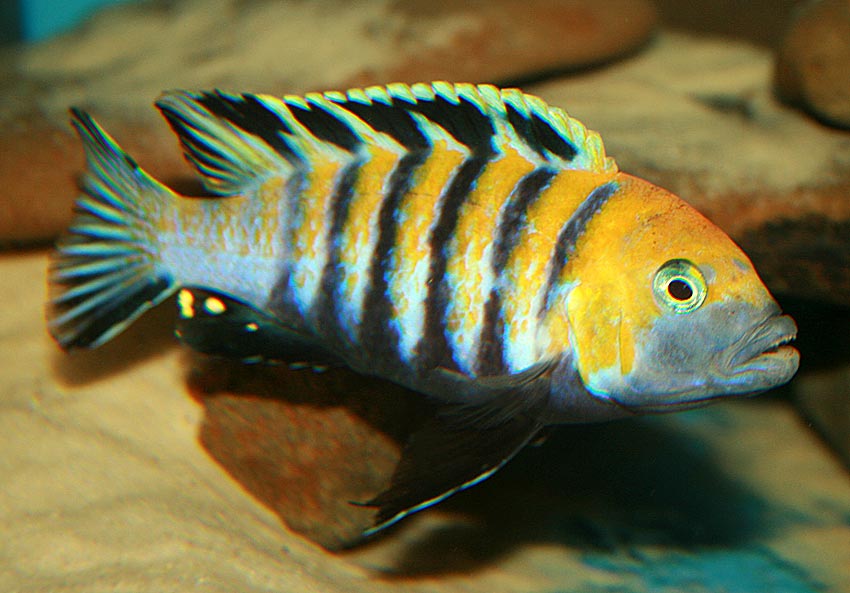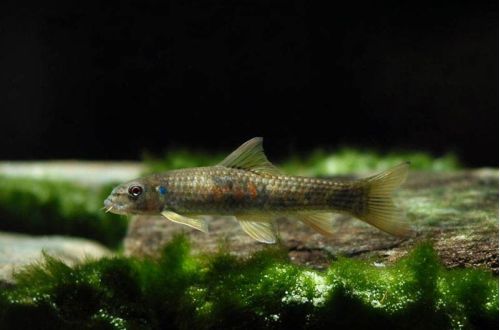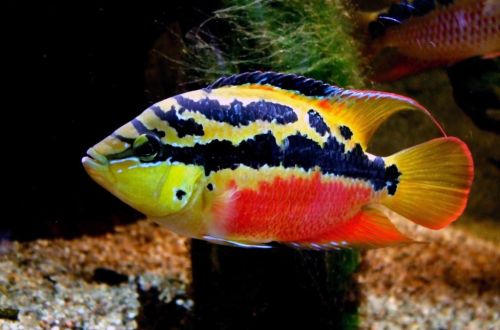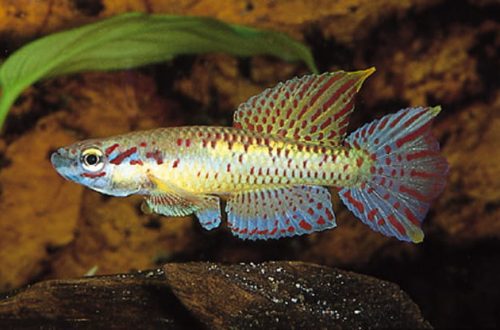
Cichlid Doggy
Cichlid Doggy or Cynotilapia Afra, scientific name Cynotilapia afra, belongs to the Cichlidae family. It has an original coloration with many variations, which, coupled with unpretentiousness, has made it a popular fish among aquarists around the world.

It belongs to a separate genus in the cichlid family, commonly called “dog-like”, for the unique structure of the teeth – Unicuspid, when the tooth has only one top, like canines in dogs and other mammals, which is not typical of other members of the family of a similar size.
Requirements and conditions:
- The volume of the aquarium – from 100 liters.
- Temperature – 23-28°C
- Value pH — 7.2–8.8
- Water hardness – medium hardness (10–18 dH)
- Substrate type – sand and/or gravel
- Lighting – moderate
- Brackish water – allowed at a concentration of 1,0002
- Water movement – strong / moderate
- Size is about 10 cm.
- Nutrition – vegetable and meat products
- Life expectancy is 7 to 10 years.
Contents
Habitat
They are endemic to Lake Malawi in Africa and are not found in any other body of water. They belong to a large group of fish under the common name Mbuna, which in translation from the local dialect means “rock dwellers”. They live in the northern and northeastern parts of the lake along the rocky coast, preferring the upper layers of water, shallow water, but it has also been found at depths of up to 20 meters.
Females stay in groups in open water, feeding on plankton, males live alone on their territory, they use hard fibrous algae that grow on rocks, which often contain various insect larvae, small crustaceans, which are also eaten.
Description

A small fish, has a somewhat elongated powerful body. The mouth is littered with many sharp teeth. The dorsal fin is long, stretching from head to tail, consisting of many spiny rays – a passive defense against large predators. The color scheme is varied, it contains blue, blue, yellow and other adjacent colors of this palette. There are several vertical dark stripes in the picture, like the stripes of a zebra. They can be both pronounced and less noticeable, especially in females.
Food
The diet consists of meat and vegetable products: live or frozen bloodworms, mosquito larvae, pieces of earthworms and / or shrimp, algae flakes. The best option is to use specialized food for cichlids from a particular lake, in this case Malawi. They contain the necessary elements and vitamins for full growth, and bloodworms and similar products can be used as a supplement.
Maintenance and care
Lake Malawi has a stable hydrochemical composition of water, characterized by a significant content of minerals and a high pH. For the correct preparation of water, it should be defended for a day and the initial composition should be determined using special kits, for example, litmus papers. The next step is to change the parameters in one direction or another with the use of reagents. All test kits and reagents should only be purchased from trusted pet stores and label instructions should be strictly followed.
Maintaining high water quality is achieved through a weekly renewal of 10-20% and the installation of a productive filtration system. It also provides the necessary internal flow. Other minimum required equipment consists of a heater, lighting and aeration systems.
In the design, rocks, large boulders, piles of stones with numerous shelters, grottoes are preferred. Small gravel substrate. If possible, use crushed coral or aragonite, which helps to increase the hardness of the water. The composition should be divided into two parts – free space for swimming and a zone with shelters. Groups of plants with a powerful root system, hard-leaved.
The dog cichlid does not belong to a schooling species, but successfully lives in small polygamous groups, where there are at least three females per male. More than one male is not allowed. In a large aquarium from 350–400 liters, the joint maintenance of other species of Lake Malawi cichlids is allowed, provided that they are not aggressive, slightly larger and differ in color and body pattern.
Sexual differences
Males have a bright coloration with rich colors, females are more faded, sometimes without pronounced stripes on the body.
Breeding / Reproduction
Successful breeding is possible in a species tank, otherwise skirmishes are possible if the females feel threatened by their offspring. Sexual maturity is reached by 6–8 months, when the fish are ready, the spawning period begins. It is easy to identify by the color of the male, it becomes brighter than usual. The female lays 10 to 20 eggs and immediately picks them up in her mouth. Then the pair unites, the male dissolves his caudal fin, in the pattern of which there are yellow dots that look like eggs. The female tries to swallow them, mistaking the drawing for real eggs, thereby stimulating the male to release milk. When they are released, the female “breathes” them and fertilization occurs.
The fry appear in 2-3 weeks, the eggs are in the mouth of the fish all this time, as in the safest place. A few more days will pass before the female leaves offspring, and until then she remains on their protection and, in case of danger, the juvenile hides back in her mouth. Feed the fry with specialized micro food, brine shrimp. Grown up fish, which the female has already left, are recommended to be placed in a separate spawning aquarium.
Fish diseases
The main problem is side diseases due to malnutrition. Not maintaining a balance between meat and plant products leads to an upset digestive system and, as a result, the fish becomes susceptible to various diseases. Similar problems arise when the water quality deteriorates and/or does not meet the required parameters. Read more about symptoms and treatments in the Aquarium Fish Diseases section.
Features
- Polygamous species, one male and several females, keeping two or more males is unacceptable
- Mandatory combination of vegetable and meat feed





